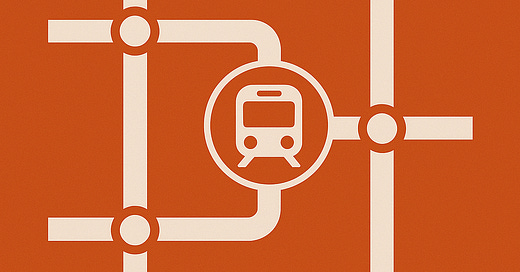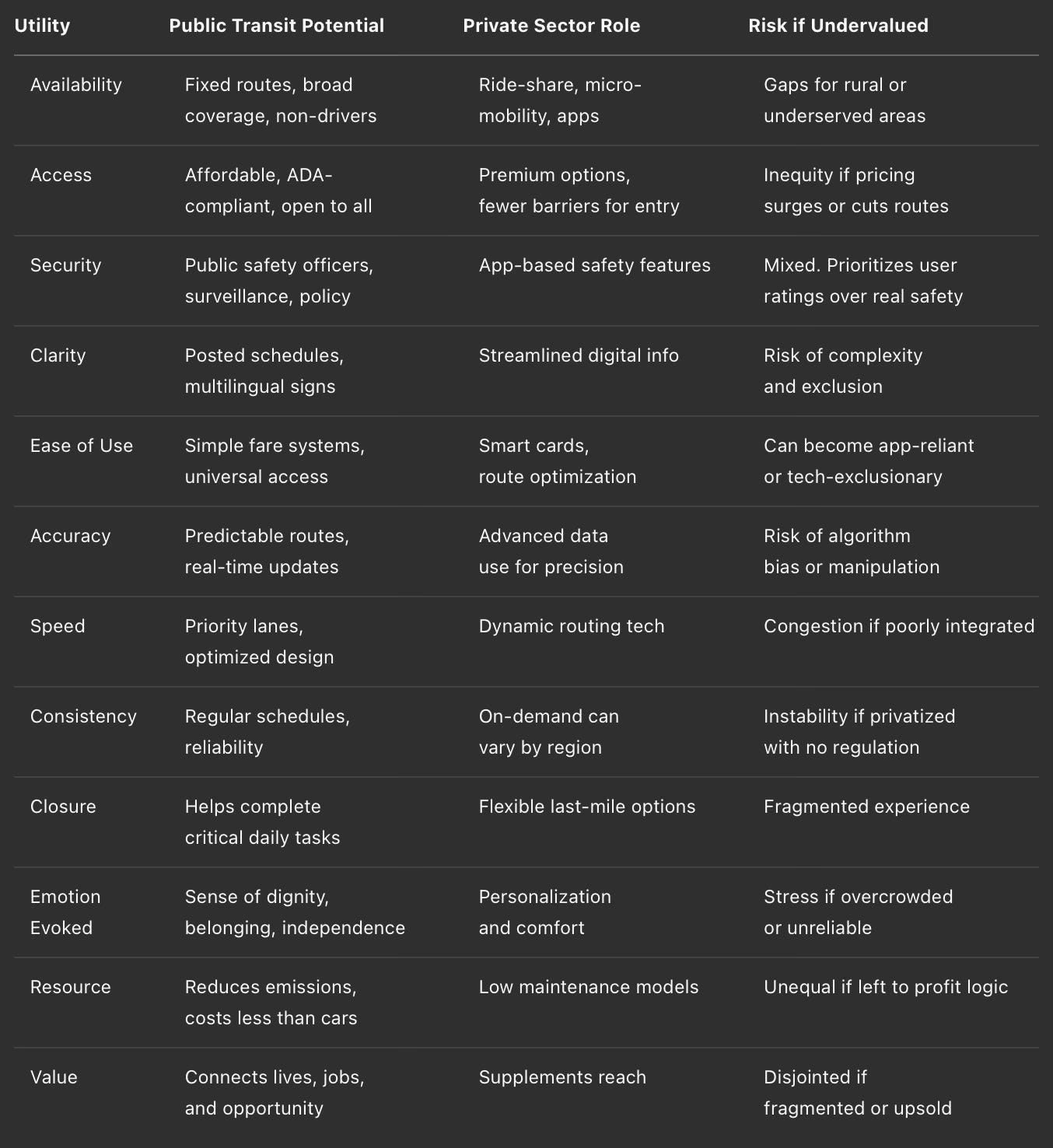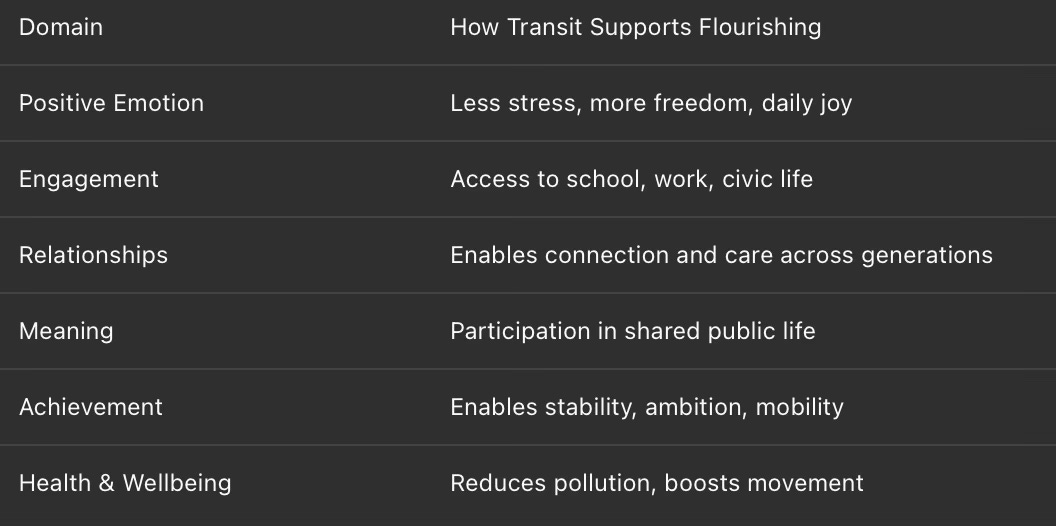THX Case Study: Public Transit — A Hybrid Model for Fairness and Function
From the THX Series Hub: Government That Works
Exploring where public investment in transit helps people flourish—and how private partnerships can help or harm.
What’s at Stake
Public transit isn’t just about moving people from point A to B. It shapes how cities grow, how families work, and who gets access to opportunity.
When public transit works, it lifts entire communities. When it fails—or never exists—it isolates, exhausts, and excludes people. And while some systems thrive with public investment, others have turned to private partnerships, often with mixed results.
So what’s the best path forward? Who should fund, manage, and maintain this daily lifeline?
THX Framework Quick Guide
The 12 Utilities — A tool to measure whether a service is useful, fair, and functional across the things people actually need.
PERMAH — A framework from positive psychology that helps us ask if something helps people truly flourish—not just survive.
Prospect Theory — A reminder that people feel losses more strongly than gains—so taking something away often hurts more than adding something helps.
Admiration Equation — Explains how people build lasting loyalty through skill, goodness, awe, and gratitude—not just results.
Micro-Moments — The little experiences that shape how people feel, trust, and remember a service—or a system—for life.
(For a deeper dive, see the full THX Framework introduction post.)
The 12 Utilities
Verdict: Public transit thrives as a publicly anchored system—with room for thoughtful private enhancements. But privatization without equity creates fragmentation, not freedom.
PERMAH Impact
Transit doesn’t just help us go—it helps us grow.
Prospect Theory: The Cost of Service Cuts
When transit routes are cut, the loss is felt fast—especially among those with no alternatives.
Every missed connection can mean lost wages, missed appointments, or social disconnection.
Once trust is broken, people don’t come back easily.
Admiration Equation
Skill: Efficient, smooth transfers and rider-first design
Goodness: Prioritizes the many over the few
Awe: A city humming at rush hour thanks to thoughtful design
Gratitude: “I got to work. I got to school. I got to be there.”
When transit is dignified and dependable, it earns loyalty—and changes lives.
Micro-Moments
A kid’s first solo bus ride to school
A parent making it to a night shift on time
A grandparent getting to a family event with ease
Transit isn’t just a system. It’s a support beam in the structure of daily life.
Real-World Examples and Lessons
New York City (MTA):
The MTA is one of the world’s largest public transit systems, but decades of underfunding have led to delays, breakdowns, and safety concerns.
Attempts to privatize maintenance contracts and infrastructure upgrades have produced mixed results—some improvements, but also bloated costs and transparency issues.
Washington, D.C. (WMATA):
The DC Metro has seen ridership drop due to safety incidents and unreliable service. Federal bailouts have helped, but critics argue a lack of long-term investment and accountability holds it back.
WMATA’s partnership with ride-share services helped restore last-mile coverage—but only for those who can afford the surge pricing.
Bogotá, Colombia (TransMilenio):
This bus rapid transit (BRT) system revolutionized mobility with low cost and high efficiency. However, underinvestment and over-reliance on private operation have led to overcrowding and public dissatisfaction.
Copenhagen, Denmark:
Copenhagen’s metro and cycling infrastructure integrate seamlessly with buses and trains. Publicly funded and locally accountable, it emphasizes dignity and access alongside environmental goals.
Lessons Learned:
Public control with private enhancement can work—but only if equity and service are non-negotiable.
When profit becomes the primary metric, the system fractures.
The best systems invite public ownership, not just financially—but emotionally and socially, too.
Final Thought
Public transit is not a luxury. It’s not a bonus for the poor or a backup for car owners. It is—at its best—a commitment to shared infrastructure, collective freedom, and the idea that dignity should not depend on owning a vehicle.
The THX frameworks reveal that transit does far more than connect places. It connects lives.
That’s why public investment matters. And why private innovation must always serve—not replace—the public good.
To move people well is to move society forward. That’s the route we should stay on.

Interpretation:
The map lines reflect more than logistics—they symbolize lives, paths, and shared space. The clean symmetry conveys the emotional and functional value of transit done right. The orange backdrop evokes urgency and public attention, while the minimalism suggests a system that works because it’s thoughtfully designed—not overcomplicated or commodified.





